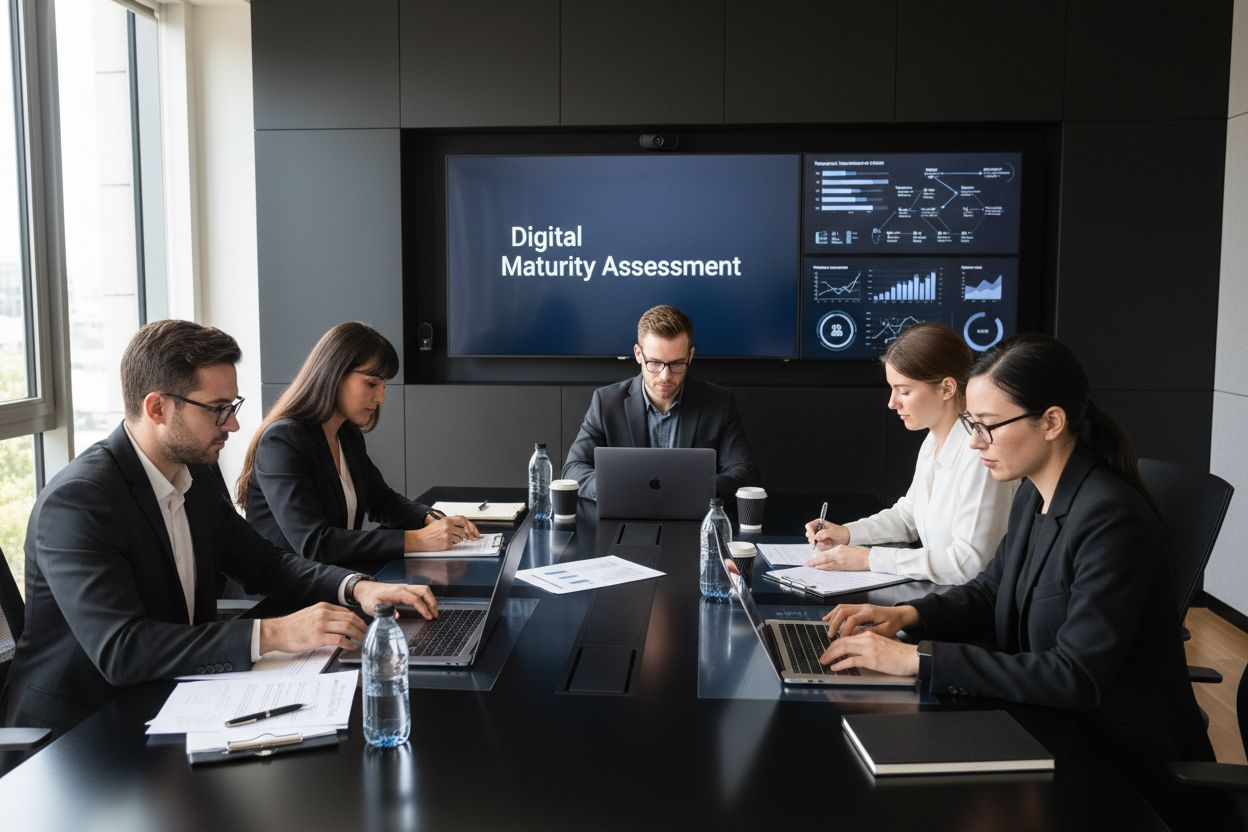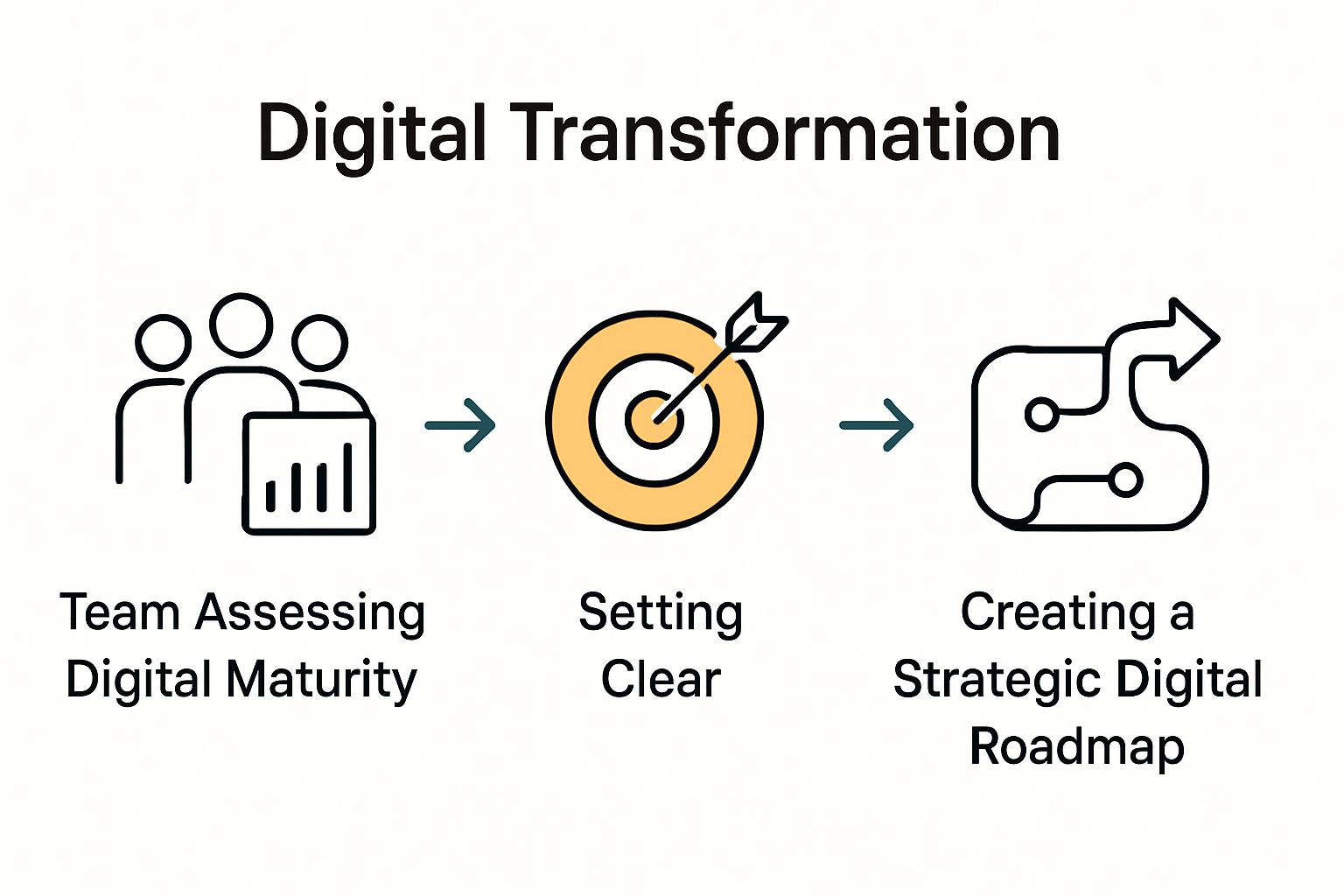10.10.25
Insurance Digital Transformation Guide for Effective Change

Insurance companies are rushing to digitize every corner of their operations. Over 70 percent of insurers now rank digital transformation as a top business priority. That sounds impressive until you realize that most companies still stumble at the very first step. The real difference between leaders and laggards is not who has the flashiest tech, but who actually knows how to measure where they really stand before making a single move.
Table of Contents
- Step 1: Assess Your Current Digital Maturity Level
- Step 2: Define Clear Transformation Goals And Objectives
- Step 3: Develop A Comprehensive Digital Transformation Strategy
- Step 4: Implement Key Technology Solutions And Tools
- Step 5: Train Staff And Drive Cultural Change In The Organization
- Step 6: Evaluate Progress And Optimize The Transformation Process
Quick Summary
| Key Point | Explanation |
|---|---|
| 1. Conduct a Digital Maturity Assessment | Evaluate your current technological capabilities and gaps using a cross-functional team approach. |
| 2. Set Specific Transformation Goals | Define actionable goals based on the digital maturity assessment using the SMART criteria for clarity and alignment. |
| 3. Create a Comprehensive Strategy | Develop a detailed roadmap for your digital transformation, considering technology, processes, and organization-wide engagement. |
| 4. Implement Key Technologies Effectively | Prioritize technology solutions that address identified gaps and adopt a phased approach to minimize disruption. |
| 5. Foster Continuous Evaluation and Adaptation | Regularly assess performance metrics and optimize processes to ensure ongoing growth and technological evolution. |
Step 1: Assess Your Current Digital Maturity Level
Digital transformation in insurance begins with a critical first step: understanding your organization’s current technological capabilities and readiness for change. This assessment serves as a strategic roadmap, revealing gaps, opportunities, and potential challenges in your digital journey.
Conducting a comprehensive digital maturity assessment requires a holistic approach that examines multiple organizational dimensions. Start by creating a cross-functional team representing IT, operations, customer experience, and strategic planning. This team will help generate a nuanced view of your current digital ecosystem.
Your assessment should systematically evaluate key areas of digital capability:
- Technology Infrastructure: Analyze existing systems, integration capabilities, cloud readiness, and legacy technology constraints
- Data Management: Evaluate data collection, analytics capabilities, and insights generation processes
- Customer Interaction Channels: Review digital touchpoints, online service capabilities, and omnichannel engagement strategies
- Operational Agility: Assess current workflow flexibility, process automation levels, and technological adaptability
Practical Tools for Digital Maturity Evaluation:
- McKinsey Digital Quotient Assessment
- Gartner Digital Business Transformation Framework
- Internal diagnostic surveys and capability mapping workshops
Successful assessments go beyond surface-level technological inventory. They require honest, transparent evaluation of organizational culture, leadership commitment, and change readiness. Be prepared to uncover uncomfortable truths about technological gaps and resistance to digital transformation.
Below is a checklist table to help verify that your digital maturity assessment is thorough and actionable before moving to the next step.
| Verification Item | Description | Sample Indicator |
|---|---|---|
| Capabilities Documented | Comprehensive record of current digital and process capabilities | Inventory of systems and workflows |
| Improvement Areas Identified | Transparent identification of technological and process gaps | List of bottlenecks and outdated platforms |
| Leadership & Culture Evaluated | Honest review of readiness for change and buy-in from leadership | Assessment notes on cultural strengths/concerns |
| Strategic Business Alignment | Assessment results mapped to business objectives | Matrix linking gaps to core business goals |
| Use of Evaluation Tools | Utilization of structured tools and frameworks for diagnosis | Completed McKinsey DQ, Gartner Framework, or surveys |
| Cross-functional Team Participation | Collaboration from multiple departments throughout the assessment | Participant list with roles and departments |
| Baseline Established for Progress | Metrics and data for future comparison and measurement | Digital maturity score or evaluation report |
Document your findings comprehensively, creating a baseline that will inform subsequent transformation strategies. Learn more about digital insurance strategies to complement your maturity assessment and develop a robust transformation roadmap.
Key verification indicators that your assessment is thorough include clear documentation of current capabilities, identified improvement areas, and a preliminary vision for digital evolution aligned with strategic business objectives.
Step 2: Define Clear Transformation Goals and Objectives
After completing a thorough digital maturity assessment, the next critical phase is defining precise, actionable transformation goals that align with your organization’s strategic vision. This step transforms your digital assessment insights into a structured roadmap for meaningful technological evolution.
Goal setting requires a meticulous approach that balances ambitious vision with pragmatic implementation. Begin by conducting collaborative workshops that bring together leadership from multiple departments. These sessions should create space for open dialogue, ensuring goals reflect both technological possibilities and business realities.
Strategic Goal Development Framework:
- Customer Experience Enhancement
- Operational Efficiency Improvements
- Revenue Generation Through Digital Channels
- Risk Management and Compliance Optimization
Each goal must be specific, measurable, achievable, relevant, and time-bound (SMART). For instance, instead of a vague objective like “improve digital capabilities,” articulate a precise target such as “reduce policy processing time by 40% through automated underwriting workflows within 18 months.”
Consider both short-term tactical objectives and long-term strategic transformations. Short-term goals might focus on immediate pain points like system integration or customer interface improvements, while long-term objectives could involve reimagining entire business models or creating innovative insurance products.
Engaging external consultants or industry experts can provide valuable perspective during this goal-setting process.
VIDEO:video_content] [Explore digital-first insurance strategies to gain additional insights into effective goal development.
To validate your goal-setting process, ensure objectives meet three critical criteria: they address capabilities revealed in your digital maturity assessment, demonstrate clear business value, and have explicit metrics for tracking progress. Successful goal definition creates a bridge between your current technological state and your desired digital future, providing a clear direction for subsequent transformation efforts.
Remember that goal setting is not a one-time event but an iterative process. Build flexibility into your objectives, allowing for periodic reassessment and adjustment as technological landscapes and business needs evolve.
Step 3: Develop a Comprehensive Digital Transformation Strategy
Developing a comprehensive digital transformation strategy represents the critical bridge between your initial assessment and actual implementation. This strategic blueprint will translate your organizational goals into actionable, structured plans that guide technological evolution and organizational change.
Begin by creating a detailed roadmap that breaks down your transformation objectives into phased, manageable initiatives.
 Each phase should have clear milestones, resource allocations, and specific technological interventions. Consider developing a multi-year strategy that allows for flexibility and iterative improvements while maintaining a consistent vision.
Each phase should have clear milestones, resource allocations, and specific technological interventions. Consider developing a multi-year strategy that allows for flexibility and iterative improvements while maintaining a consistent vision.
Key Strategic Considerations:
- Technology Infrastructure Modernization
- Data Architecture Enhancement
- Process Automation Strategies
- Talent and Skills Development
- Change Management Protocols
Successful strategies recognize that digital transformation extends far beyond technological implementation. It requires a holistic approach addressing organizational culture, workforce capabilities, and strategic alignment. Engage stakeholders from across the organization to build a shared understanding and commitment to the transformation journey.
Technology selection plays a pivotal role in strategy development. Prioritize solutions that offer scalability, interoperability, and alignment with your specific insurance business needs. Learn about the key drivers of digital transformation to refine your strategic approach and understand industry best practices.
Risk management must be integral to your strategy. Develop comprehensive risk assessment frameworks that evaluate technological, operational, and cybersecurity implications of proposed digital initiatives. This proactive approach helps mitigate potential implementation challenges and ensures regulatory compliance.
Verification of a robust strategy involves multiple dimensions. Look for clear evidence of cross-functional alignment, detailed implementation timelines, defined performance metrics, and a transparent change management approach. Your strategy should articulate not just technological interventions but also the expected business outcomes and cultural transformations required to drive successful digital evolution.
Step 4: Implement Key Technology Solutions and Tools
Implementing key technology solutions represents the pivotal moment where strategic planning transforms into tangible technological capabilities. This step demands a precise, methodical approach that balances technological innovation with operational practicality.
Begin by prioritizing technology solutions that directly address the gaps identified during your digital maturity assessment. Focus on platforms and tools that offer seamless integration, scalability, and robust performance across your insurance ecosystem.
Below is an overview table summarizing essential technology solutions to prioritize and their primary purpose during your insurance digital transformation.
| Technology Solution | Main Purpose | Example Use Case |
|---|---|---|
| Cloud-native Infrastructure | Scalability, flexibility, and integration | Hosting core insurance platforms |
| Data Analytics Platforms | Insight generation, performance measurement | Claims fraud detection, predictive pricing |
| Automated Workflow Systems | Process efficiency, speed, and consistency | Policy issuance, underwriting automation |
| Cybersecurity Tools | Data protection, compliance, and risk reduction | Securing customer information |
| AI Customer Interaction Tech | Enhance digital customer engagement experiences | Chatbots, digital claims assistants |
Essential Technology Implementation Considerations:
- Cloud-native infrastructure capabilities
- Advanced data analytics platforms
- Automated workflow management systems
- Cybersecurity and compliance tools
- AI-powered customer interaction technologies
Successful implementation requires more than technical deployment. Create a comprehensive change management strategy that prepares your workforce for technological transitions. This involves targeted training programs, communication protocols, and support mechanisms that help employees adapt to new technological environments.
Careful vendor selection becomes critical during this phase. Evaluate potential technology partners based on their track record, integration capabilities, ongoing support, and alignment with your specific insurance business requirements. Explore low-code and no-code transformation strategies to understand flexible technological implementation approaches.
Phased implementation strategies minimize operational disruption. Consider rolling out technologies incrementally, starting with less critical systems and progressively expanding to core operational platforms. This approach allows for continuous learning, risk mitigation, and course correction.
Verification of successful technology implementation extends beyond technical deployment. Look for measurable improvements in operational efficiency, customer experience metrics, and employee productivity. Establish clear key performance indicators that demonstrate the tangible business value generated by your technological investments.
Step 5: Train Staff and Drive Cultural Change in the Organization
Transforming technological infrastructure means little without corresponding organizational culture change. This critical step focuses on empowering your workforce to embrace digital transformation through comprehensive training, strategic communication, and a holistic approach to cultural evolution.
Begin by developing a multi-tiered training program that addresses different skill levels and technological familiarity across your organization. Customized learning pathways are essential, recognizing that employees have varied technological backgrounds and learning needs. Create a mix of formal training sessions, hands-on workshops, online learning modules, and peer-to-peer knowledge sharing platforms.
Key Training and Cultural Change Components:
- Leadership-driven digital transformation advocacy
- Role-specific technological skill development
- Continuous learning and adaptation mechanisms
- Psychological safety for technological experimentation
- Reward systems aligned with digital innovation
Effective cultural transformation requires visible commitment from senior leadership. Executives must not only endorse digital initiatives but actively demonstrate technological engagement. This means participating in training programs, championing innovative approaches, and communicating the strategic importance of digital evolution.
Explore strategies for enhancing customer experience through digital transformation to understand how technological skills directly impact organizational performance.
Address potential resistance by creating safe spaces for employees to voice concerns, ask questions, and provide feedback about technological changes. Develop mentorship programs where technologically adept employees can support colleagues struggling with new systems. Recognize and celebrate early adopters and innovative thinkers who demonstrate exceptional adaptation to digital tools.
Verification of successful cultural transformation extends beyond training completion rates. Look for tangible indicators such as increased technological self-sufficiency, reduced support ticket volumes, proactive problem-solving behaviors, and a measurable shift in organizational communication and collaboration patterns. Remember that cultural change is an ongoing journey requiring continuous investment, patience, and adaptability.

Step 6: Evaluate Progress and Optimize the Transformation Process
Evaluating progress represents the critical reflection point of your digital transformation journey, where strategic insights transform into continuous improvement. This step moves beyond passive measurement, focusing on dynamic assessment and proactive optimization of your technological evolution.
Establish a comprehensive measurement framework that captures both quantitative performance metrics and qualitative organizational insights. This approach requires developing a balanced scorecard that tracks technological implementation, operational efficiency, employee engagement, and customer experience indicators. Regular assessment intervals allow for timely interventions and strategic recalibration.
Key Performance Evaluation Dimensions:
- Technological adoption rates
- Operational cost savings
- Customer satisfaction metrics
- Employee digital competency improvements
- Revenue generation through digital channels
Create cross-functional review panels that bring together perspectives from technology, operations, customer experience, and strategic planning teams. These collaborative assessment sessions should critically examine not just technological performance, but also organizational readiness and cultural transformation progress.
Explore advanced insurance analytics strategies to enhance your measurement and optimization capabilities. Leverage data-driven insights to identify potential improvements, emerging technological opportunities, and areas requiring further investment or intervention.
Optimization is an iterative process demanding continuous learning and adaptive strategies. Develop mechanisms for rapid experimentation, allowing teams to test incremental improvements without significant operational disruption. Encourage a culture of constructive feedback, where employees at all levels can contribute insights about technological implementation challenges and potential solutions.
Successful evaluation goes beyond collecting data. It requires translating insights into actionable strategies. Look for evidence of proactive problem-solving, demonstrated technological adaptability, and a measurable trajectory of organizational digital maturity. The ultimate verification is an organization that views digital transformation not as a one-time project, but as an ongoing journey of continuous innovation and strategic evolution.
Ready to Accelerate Your Insurance Digital Transformation?
You have just learned about the essential steps to assess digital maturity, set the right goals, and choose technologies that truly make a difference in the insurance industry. But turning these plans into real, lasting results can be complex. Many insurers struggle with outdated systems, slow product launches, and limited digital customer engagement. You are likely looking for a way to overcome integration challenges, simplify your processes, and ensure you stay ahead in an evolving market.
Discover how IBSuite from Insurance Business Applications can bridge these gaps. IBSuite is a secure, end-to-end core insurance platform trusted globally by leading P&C insurers. It addresses the specific needs identified in your transformation journey with cloud-native architecture, seamless integration, and flexible automation. If you want to modernize your core systems and achieve rapid, measurable results, now is the perfect time to act. See how IBSuite powers digital-first insurance strategies and explore key drivers of successful transformation. Take the next step toward your digital future by booking a demo today.
Frequently Asked Questions
What is the first step in the digital transformation process for insurance?
Understanding your organization’s current digital maturity level is the crucial first step. This involves assessing your existing technological capabilities, identifying gaps, and outlining opportunities for improvement.
How can organizations define effective digital transformation goals?
Organizations should define SMART goals—specific, measurable, achievable, relevant, and time-bound. Goals can include enhancing customer experience, improving operational efficiency, or optimizing risk management.
What role does technology play in digital transformation in the insurance industry?
Technology serves as the backbone of digital transformation. Key technology solutions include cloud infrastructure, data analytics platforms, process automation systems, and cybersecurity tools that support overall operational efficiency and customer engagement.
How can organizations evaluate their progress in digital transformation?
Organizations should establish a measurement framework incorporating both quantitative and qualitative metrics. This includes tracking technological adoption rates, operational cost savings, customer satisfaction, and employee digital competency to ensure continuous improvement.
Recommended
- Enhancing Customer Experience with Digital Transformation – Digital Insurance Platform | IBSuite Insurance Software | Modern Insurance System
- Understanding Digital-First Insurance Strategies – Digital Insurance Platform | IBSuite Insurance Software | Modern Insurance System
- 2025 Guide to Insurance Analytics: Transform Your Decisions – Digital Insurance Platform | IBSuite Insurance Software | Modern Insurance System
- Drivers of Digital Transformation in the Insurance Industry – Digital Insurance Platform | IBSuite Insurance Software | Modern Insurance System
- Top Digital Marketing Techniques for 2025: A Complete Guide
- Embracing Tomorrow: The Leadership Guide to Digital Transformation